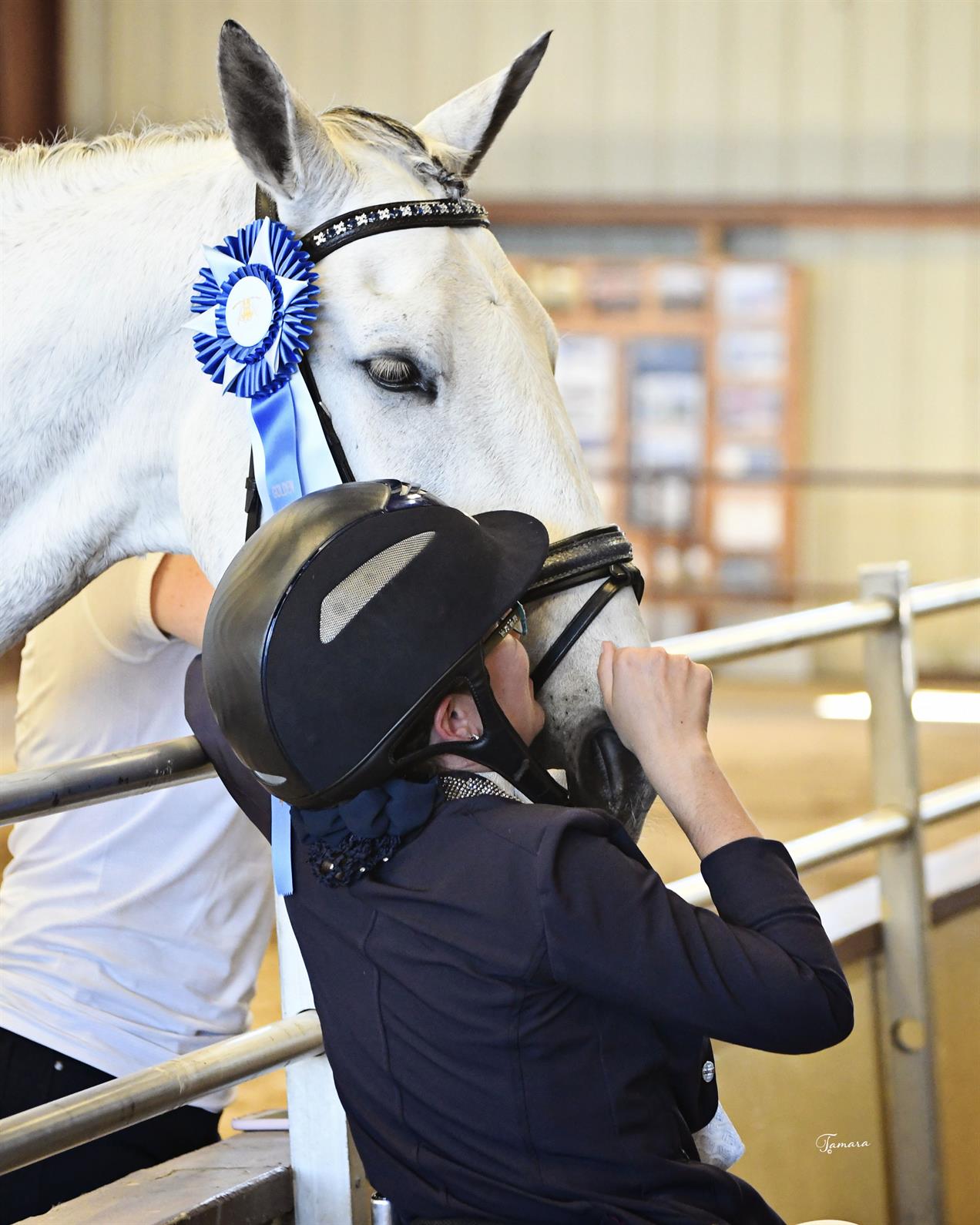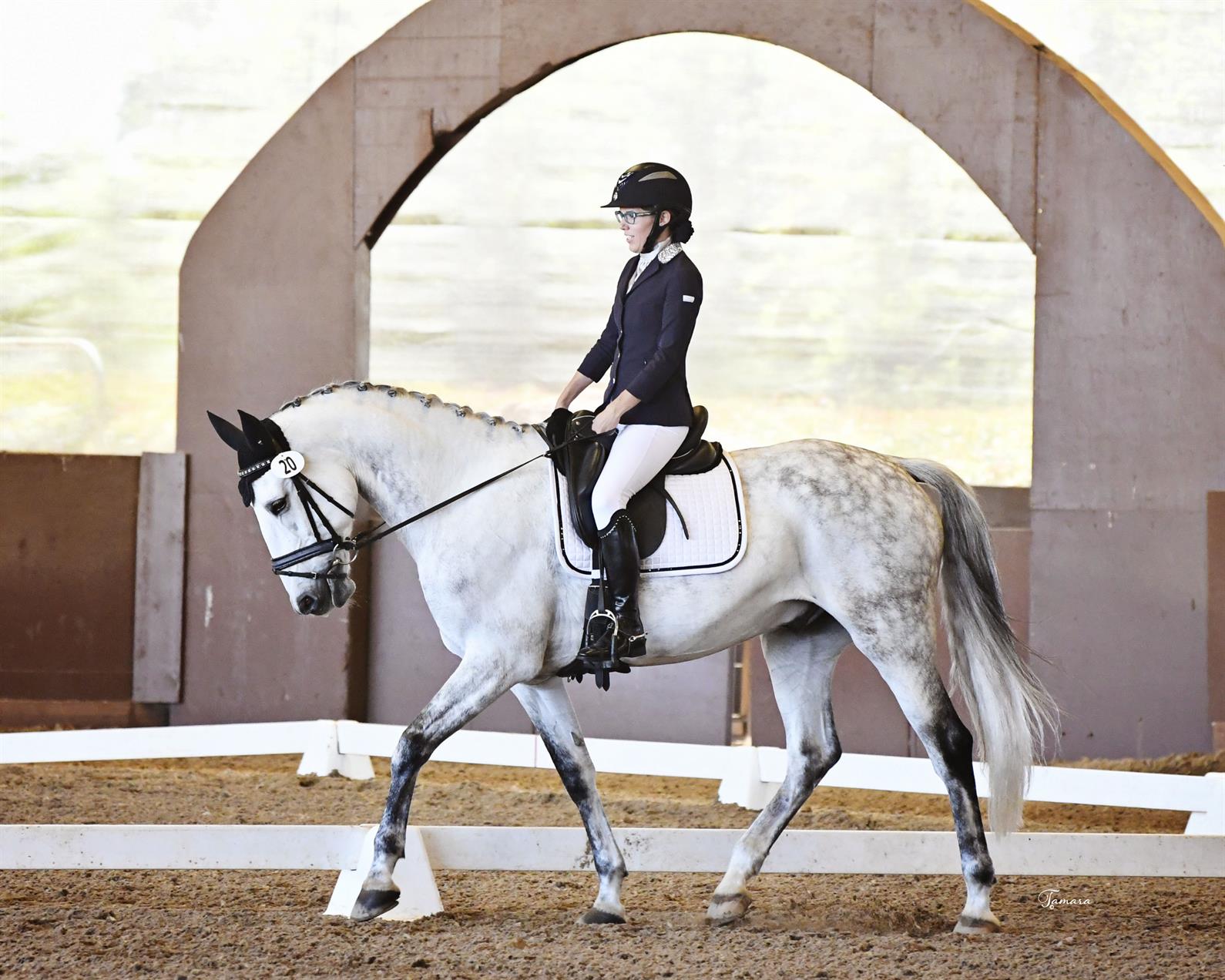If someone had told Alanna Flax-Clark 15 years ago that she’d be pointing for the 2020 Paralympic Games in para-dressage, she probably would have laughed and said, “What’s dressage?”
“I was never that girl running around in cowboy boots with all my Breyer horses when I was younger,” Flax-Clark, 34, says in her website bio. “I knew nothing about horses! They only came into my life at a time when I needed them the most.”

(Photo: Tamara Torti)
When she was 13, Flax-Clark was diagnosed with a chronic neurological disease that affected her bones, muscles, nerves, skin, and blood vessels. That began a series of hospital stays, surgeries, therapy regimens, and other treatments. In the meantime, Flax-Clark continued her studies. She majored in biology and psychology at Rhodes College in Memphis, Tenn., earned a Master of Science in education at Simmons College, in Boston, Mass., and got a full-time position working with special-needs children. But in 2007, when she was 24, Flax-Clark’s health took a sudden and dramatic downturn after she contracted a serious infection. In its aftermath, she was weakened and frustrated by her lack of progress in rehabilitation.
“I had been a special ed teacher, and some of my students used hippotherapy as a form of speech therapy, occupational therapy, and physical therapy,” she recalled. “It was always the best part of their week, and I saw the changes in them from the therapy—emotionally, physically, there were so many different changes. I was getting really frustrated with my rehab, and I wasn’t seeing any changes in myself. At that point I was really weak, I was spending basically all week in bed. I didn’t have the energy or the strength to get out, and emotionally I was in such a different place than I am now. So I knew something had to change.
“I was a person who had enjoyed being outdoors. I was physically active. So I thought, ‘Why don’t I try this?’ I was just looking for something to help me.”
Flax-Clark, who lives in Granada Hills, Calif., found her door into the equestrian world at Ride On, a therapeutic horsemanship center in Chatsworth, California.
“At the time, my doctor didn’t think it was safe for me,” Flax-Clark said. “So I said, ‘Okay, well, I’m going to find a different doctor.’ I found a doctor that supported me, because I feel that if you’re motivated by something, your motivation is the thing that’s going to help you the most.”
For her first ride, Flax-Clark recalls, there were three or four people holding her on the horse for a ride that lasted five to 10 minutes. She was hooked and started riding once a week.
“That was all my body could physically handle,” she said. “But the thing that’s so cool about it is that the horse’s movement and gait actually matches the human gait. It has the same movement as our pelvis. So anytime our movement is out of sync, we can actually borrow the horse’s movement to put us back in rhythm. The movement and sensory input from the horse can be used to address things such as posture, balance, coordination, or mobility in people with disabilities.
“And once I started, I saw so many changes emotionally and physically, and I wanted to be challenged every day. Even if I went once a week and then I got sick for three weeks, we always saw the little changes pick up. It wasn’t like I backtracked and then had to start all over.
“We have videos where, at the beginning, they would ask the horse to halt, and I would just completely fall over if no one was holding me up,” she continued. “I was so weak that even at a walk I wasn’t able to hold my head and neck up. Then I got the strength to hold my head and neck up better as we were walking. Then I went from being on the horse from 10 minutes to 15 minutes or maybe 20 minutes, and I didn’t have to sleep afterwards.
“It carried over into other things in my life. I got stronger to be able to push my wheelchair better and do more things at home. So I started to become more independent at home and do things on my own. That’s a huge thing at my age. I want to be able to go out with friends or be independent to get my own breakfast or do the laundry.”
Flax-Clark says horses also helped her regain her voice, which had been reduced to a whisper after her illness damaged her vocal cords.

“I could no longer talk on the phone, order my own food in a restaurant, or communicate for myself,” she said. “Being around the horses, you didn't have to verbally communicate. They always knew if I was having a good day or bad day, or what I needed from them.
“I've had my voice back for the last couple years now,” Flax-Clark added, “but the horses and dressage were really that place where I gained my independence and learned to communicate and express myself, all in an environment with animals that never once judged me or questioned my disability.“
Today, Flax-Clark rides with trainer Sabine Schut-Kery at El Campeon Farms in Thousand Oaks, Calif. Her partner in dressage is Reál Erbeo, a 12-year-old Lusitano gelding that Flax-Clark calls “a saint.”
When she went looking for a horse, Flax-Clark had a list of important criteria. In addition to exceptional gaits that could achieve top scores, she also had other factors to consider for para-dressage.
“He needs to be safe,” Flax-Clark explained. “I mount from my wheelchair, so it has to be a horse that’s comfortable with me doing that. I ride with two whips that basically act in place of my legs, so my horse has to be a horse that’s not spooky with whips.
“I can’t grip with my hands; my reins have loops that go around my wrists, and they’re at a fixed length. So a horse has to be pretty good with that, because I can’t really change the length of my reins. And I ride off of voice commands, so my horse has had to learn a lot. My trainer warms him up every day, so he has to deal with what she wants him to do, and then he has to work for me.”
Reál Erbeo’s job is “mentally challenging,” Flax-Clark noted, because of all he has to learn—not just in terms of dressage, but also about her. The Lusitano’s temperament and way of going make him a perfect match for her.
“The horse I started off on for many years when I was doing hippotherapy was an Andalusian, so I know the movement is really good for my body,” she said. “The gaits are very smooth, and it’s good for my body, as far as how much movement and impact it can take. When I was looking, I kind of had that in the back of my brain.
“His gaits are very fluid, and he’s very safe,” Flax-Clark said of Reál Erbeo, whose barn name is Royal. “I can take him anywhere. I was just at a show that had 30-mile-per-hour winds, and horses were going crazy. I was on him everywhere, and he never gave me a problem. He’s very loving. He’s very sensitive to my needs. Even if there’s anything scary going on in the environment when I’m riding him, he knows he has to take care of me, which is interesting. It’s not that he’ll do anything bad with anyone else, but he seems to always be extra-cautious with me, which I appreciate.”
Flax-Clark and Reál Erbo are pointing for the USEF Para-Equestrian Dressage National Championship sponsored by Deloitte, which takes place Sept. 14-17 at the Tryon International Equestrian Center in North Carolina. Her aim is to get to the 2020 Paralympic Games in Tokyo, but discovering horses and dressage already has given Flax-Clark something even more valuable than a medal.
“That’s something that draws me into dressage: I’m pushed to be the best I can. It’s not just everyone with a disability,” Flax-Clark said. “When I’m on my horse, no one should be able to tell what my disability is. When I go to all the local shows, I’m judged by the same judges as Sabine is, so they shouldn’t know that there’s anything different between me when I’m on my horse and Sabine when she’s on her horse. That’s a huge thing for me. When I’m in my chair, everyone knows I have such an obvious disability, but when I’m on my horse, there’s nothing different about me.”
To learn more about para-equestrian sports, including para-dressage and para-driving, visit our para-equestrian page and the United States Para-Equestrian Association. To learn more about Andalusians and Lusitanos, visit the International Andalusian & Lusitano Horse Association. To find out more about Alanna Flax-Clark, visit her website at alannaflax-clark.com.
Want articles like this delivered to your inbox every week? Sign up to receive the Equestrian Weekly newsletter here.
This article is original content produced by US Equestrian and may only be shared via social media. It is not to be repurposed or used on any other website than USequestrian.org.


